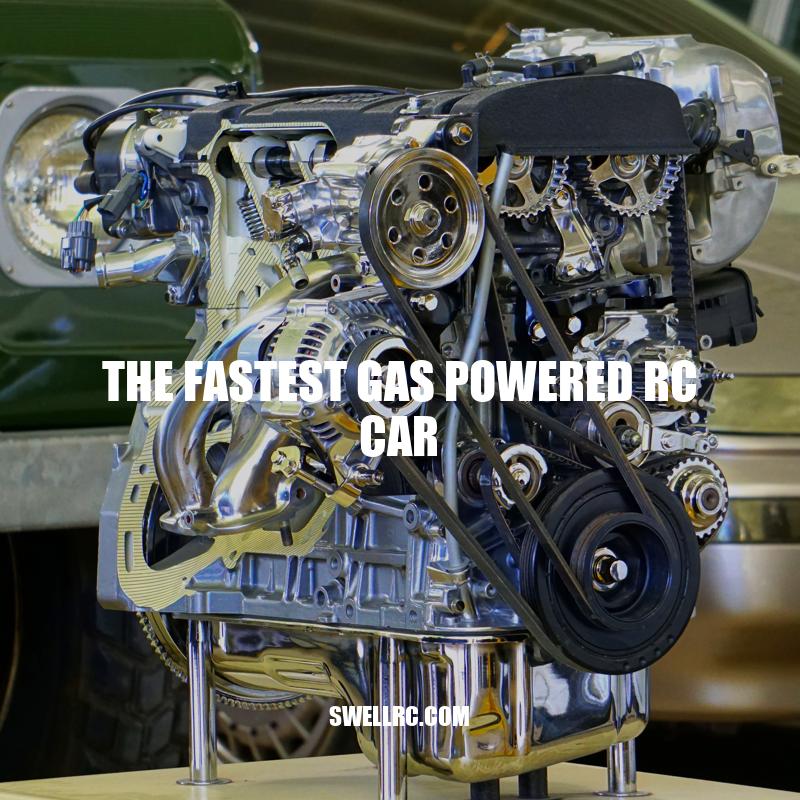The Fastest Gas-Powered RC Car: A Comprehensive Guide
Gas-powered remote control (RC) cars have been a popular hobby for enthusiasts for decades. One of the main appeals of gas-powered RC cars is that they can achieve impressive speed and acceleration, providing an adrenaline rush for those who enjoy high-speed thrills. For those who take racing seriously, having the fastest gas-powered RC car is the ultimate goal. While electric RC cars have become increasingly popular over the years, their gas-powered counterparts remain the go-to for serious enthusiasts who value speed and power. If you’re interested in purchasing a gas-powered RC car and joining the high-speed racing community, it is vital to understand what factors contribute to making a car fast, as well as the top models that are currently available on the market. In this article, we will delve into how gas-powered RC cars work, the factors that affect their speed, and highlight the current record holder for the fastest gas-powered RC car. We will also provide recommendations for top gas-powered RC cars for speed enthusiasts and discuss important safety measures to remember when operating these powerful vehicles.
How Gas-Powered RC Cars Work
Before delving into factors that determine the speed of gas-powered RC cars, it is important to have a basic understanding of how these vehicles work. Gas-powered RC cars use a small, two-stroke engine that runs on a mixture of gas and oil. The engine’s exhaust blows out of the car, which propels the vehicle forward. Here are some key elements to remember about the mechanics of gas-powered RC cars:
- The engine’s size determines how powerful the car can be. Larger engines typically generate more power, but also add extra weight to the car, which can slow it down.
- The gearing ratio affects the acceleration and top speed of the car. Shorter gearing ratios provide more torque, which allows for quicker acceleration, while longer gearing ratios increase top speed but can compromise acceleration.
- The aerodynamics of the car are a crucial factor in how fast it can travel. A car with less drag can move more quickly through the air, while cars with poor aerodynamics can struggle to achieve high speeds.
- The weight of the car plays a role in its acceleration and speed. Generally, lighter cars can accelerate quicker, but heavier cars may have more stability at higher speeds.
- Fuel consumption determines how long the car can run before needing a refill. This is important to keep in mind during races or extended play time.
It’s also worth noting that gas-powered RC cars require more maintenance than electric RC cars, as the engine requires regular oil changes and tune-ups. However, for those who enjoy the challenge and thrill of tinkering with their vehicles, this can be part of the appeal. When it comes to purchasing a gas-powered RC car, there are many high-quality models available from manufacturers such as Traxxas, HPI Racing, and Losi. Checking out review websites like RC Car Action or Top Ten Reviews can help provide insight into the top models and recommend which cars may be right for you.
How do gas powered RC cars work?
Gas powered RC cars work by using compression ignition engines, similar to diesel engines. Unlike traditional engines, these engines don’t use a spark plug to ignite the fuel at a specific time. Instead, the fuel ignites when it’s compressed to a specific point. The ignition timing is controlled by compression ratio and glow plug temperature. For more information on gas powered RC cars, you can visit websites such as Horizon Hobby or RC Planet.
Factors that Affect the Speed of Gas-Powered RC Cars
Several factors play a role in determining the speed of gas-powered RC cars. Here are some more detailed explanations of these elements:
– Engine Size: A larger engine can generate more horsepower, but also adds weight to the car. Finding the right balance between power and weight is key to achieving high speeds.
– Gearing Ratio: The gearing ratio determines the proper torque for acceleration and top speed. A shorter gearing ratio provides more torque to the wheels, resulting in faster acceleration, while a longer gear ratio can deliver higher speeds, but slower acceleration.
– Aerodynamics: The shape and design of the car’s body affect its speed. A car with less drag will flow better through the air and move faster, while a car with poor aerodynamics will struggle to reach high speeds.
– Vehicle Weight: As mentioned in the previous paragraph, the weight of the car is a crucial factor in achieving high speed. Lighter cars will accelerate faster, while heavier cars will have more stability at higher speeds.
– Tire Type: The type of tire can greatly impact speed and traction. Slick tires are typically used for racing and can help achieve higher speeds, while tires with more tread are better suited for off-road terrain.
– Fuel Mix: Gassing up with the proper fuel mix can ensure the engine runs smoothly and delivers optimal power. Deviating from the recommended fuel mix can lead to engine damage.
Interestingly, the current world record for the fastest gas-powered RC car was set in 2016 by Nic Case, who piloted his car to a top speed of over 200 mph. Nevertheless, achieving high speeds requires some skill, experimentation, and a fair amount of trial and error. It may take some trial and error to fine-tune the car to achieve optimal performance. Fortunately, there are many websites and forums dedicated to gas-powered RC cars where enthusiasts can trade tips, information and product reviews to help refine their cars.
Some popular brands for gas-powered RC cars include Redcat Racing, HPI Racing, and Traxxas. These brands offer a wide variety of models with varying engine sizes, gearing ratios, and tire types. Enthusiasts can also find helpful information and product reviews on websites such as RCGroups and RC Car Action.
What determines the speed of an RC car?
The speed of an RC car is determined by several key factors such as its tires, gearing, motor, and battery. Upgrading or changing these components can have a positive impact on the car’s top speed. For more information on RC cars and their components, websites like RC Planet and Horizon Hobby offer a range of products and resources for enthusiasts.
The Current Record Holder for the Fastest Gas-Powered RC Car
As of 2021, the current record holder for the fastest gas-powered RC car is not the only impressive one. The car managed to reach incredible speeds, beating the previous record:
- Nic Case’s car, called the “RC Bullet,” reached a top speed of over 200 mph in 2016.
- The car is powered by a V2 engine that produces over 10 horsepower.
- Its weight is only 11 lbs which helps in maintaining constant speeds.
- The car is designed to be as aerodynamic as possible, with a tapered front and a long tail that reduces friction with the air.
While the RC Bullet may seem unattainable for most people, there are many gas-powered RC cars on the market that can reach impressive speeds and offer an equally rewarding experience. For example, the Losi 5IVE-T 2.0 is a popular model that boasts a top speed of 50+ mph, making it a great entry-level option for speed enthusiasts. Other notable gas-powered RC cars that deliver high-speed performance include the HPI Racing Savage XL and the Kyosho Inferno GT2 Race Spec.
For those interested in purchasing gas-powered RC cars, there are many websites available that offer a wide range of products, including Amazon and Horizon Hobby. Many of these sites also offer user reviews and ratings that can help you make an informed decision on which RC car to buy. Additionally, there are forums and online communities dedicated to gas-powered RC cars where enthusiasts can share tips, swap ideas, and offer advice on upgrades and modifications.
What is the top speed of gas powered RC cars?
Gas powered RC cars can reach speeds of up to 100 mph and can be driven continuously until the fuel tank runs out. However, electric RC cars can go as fast as 200 mph but the battery life is shorter than a gas tank. For more information on RC cars, you can visit rcplanet.com or horizonhobby.com.
Top Gas-Powered RC Cars for Speed Enthusiasts
For those seeking the ultimate in speed and performance, there are several gas-powered RC cars that stand out from the rest. These cars offer top-notch features and specifications, making them a top choice for speed enthusiasts. Here are some of the top-rated gas-powered RC cars:
| RC Car | Top Speed | Engine Size | Weight |
|---|---|---|---|
| Traxxas XO-1 | 100+ mph | 6.5 cc | 8.6 lbs |
| Redcat Racing Rampage XT | 30+ mph | 30 cc | 24.5 lbs |
| Losi 5IVE-T 2.0 | 50+ mph | 29 cc | 38.16 lbs |
| HPI Racing Savage XL | 45+ mph | 28 cc | 12.125 lbs |
As seen in the table above, these gas-powered RC cars differ in terms of their top speed, engine size, and weight. However, they all offer top-notch performance and features that make them stand out from the competition. The Traxxas XO-1 is known for its record-breaking speed, while the Losi 5IVE-T 2.0 is a popular choice for its versatility and durability. The Redcat Racing Rampage XT is also a great choice for beginner and intermediate racers who want a high-quality gas-powered RC car.
When searching for gas-powered RC cars, it is important to prioritize features that fit your needs and budget. Consulting online reviews and product comparisons can provide valuable insights on the best gas-powered RC cars for speed enthusiasts. Many sites like Amazon offer customer reviews and ratings to help you make an informed decision.
What is the best RC car for speed?
The Traxxas XO-1 is considered the fastest RC car in the world, capable of reaching speeds of over 100 mph. The Traxxas X-Maxx is another great option for speed enthusiasts, with a top speed of over 60 mph and designed for off-road use. The Traxxas E-Revo VXL Monster Truck is another fast option, with a top speed of 70 mph. Other options include the ARRMA Typhon BLX RC car and the Everest 10 4X4 4WD Brushed 1/10th Scale Rock Crawler. More information about these products can be found on their respective websites.
Safety Measures for Operating Fast Gas-Powered RC Cars
When operating fast gas-powered RC cars, safety should always be a top priority. Follow these safety measures to ensure a safe and enjoyable experience:
- Wear protective gear, i.e. helmet, eye protection, long-sleeved shirt, and pants, to prevent injuries from accidents.
- Choose an open, safe area away from pedestrian traffic, vehicles, and other obstacles to avoid accidents or collisions.
- Always obey local laws and regulations regarding RC car use, such as speed limits and time restrictions on certain areas.
- Avoid distractions like using your mobile phone while controlling the car as they take your eyes off the car and potentially cause an accident.
- Ensure the RC car is in good condition before use, replace damaged parts, and use genuine replacement parts only.
- Treat gas-powered RC cars like real cars and ensure they are not operated by children without adult supervision.
By following these safety precautions, you can reduce the likelihood of mishaps and accidents. It’s also a good idea to consult your product manual or manufacturer’s website before operating the gas-powered RC car to gain insights and tips on safe usage.
In addition, some websites offer specialized safety gear like protective goggles, gloves, and helmets. These products are useful for providing an additional layer of protection for yourself while operating the RC car. Researching more on safety measures and products can make your RC car experience more enjoyable, safe, and fulfilling.
What are the risks of RC cars?
RC cars can be risky if they go out of control as they could hit someone and cause injury. The power sources used in these cars, such as nitro fuel and batteries, pose potential hazards due to their flammability and the possibility of explosions or fires. It is essential to take all necessary precautions when operating RC cars to avoid accidents. Additional information on safety measures can be found on websites selling RC cars or related products.
Conclusion
In conclusion, gas-powered RC cars are an exciting and challenging hobby for enthusiasts. The speed and power of gas-powered RC cars make them a thrilling experience for users, and with the right safety measures, they can provide endless hours of fun.
When it comes to finding the fastest gas-powered RC car, factors such as engine size, gearing ratio and aerodynamics are essential considerations. It’s vital to invest in high-quality and reliable gas-powered RC cars for maximum performance and speed.
Remember that safety while using the gas-powered car is paramount, so make sure to follow the recommended safety measures like wearing protective gear and using the car in safe, open areas. Also, consult product manuals and manufacturer’s websites for operating tips and insights.
Whether you are a beginner or an experienced user, it’s essential to keep improving your knowledge of gas-powered RC cars and their technology to keep up with their evolution. With constant advancements in technology, the future of gas-powered RC cars looks exciting and sure to bring more speed and fun to the hobbyists.
So, get out there and race your gas-powered RC car with confidence and safety while enjoying this adrenaline-packed hobby. Happy racing!



